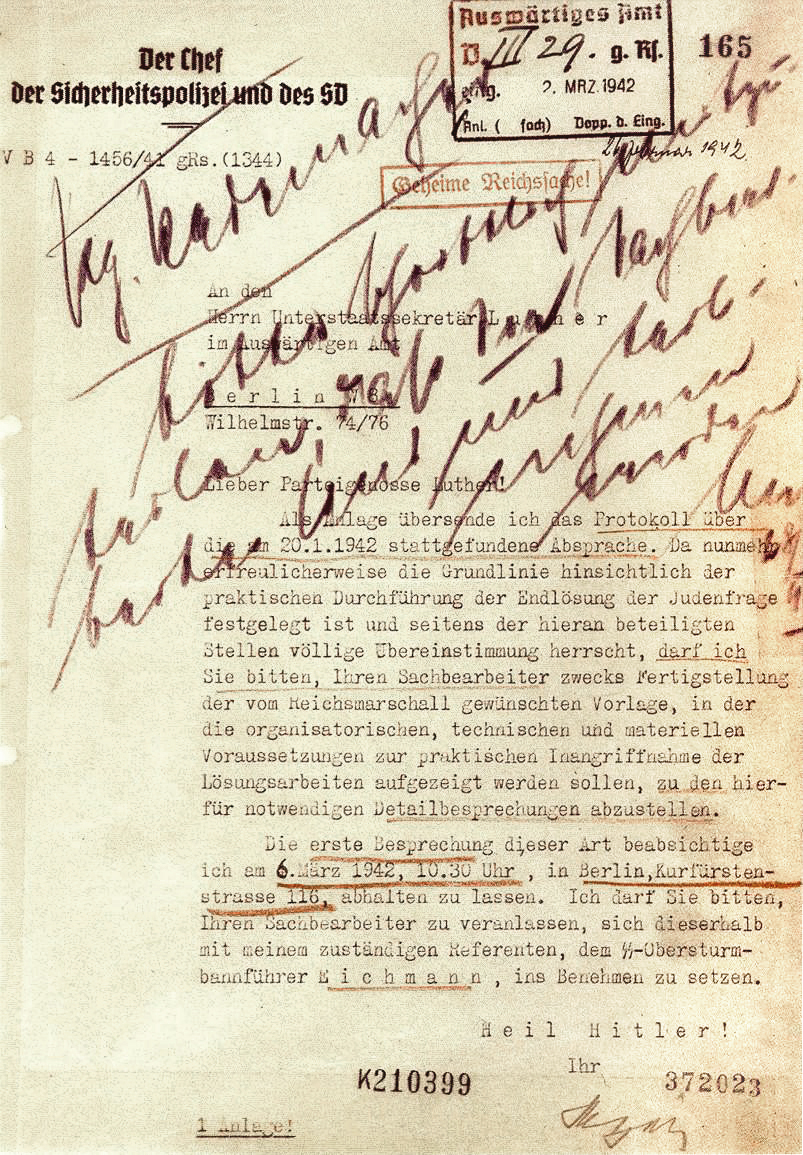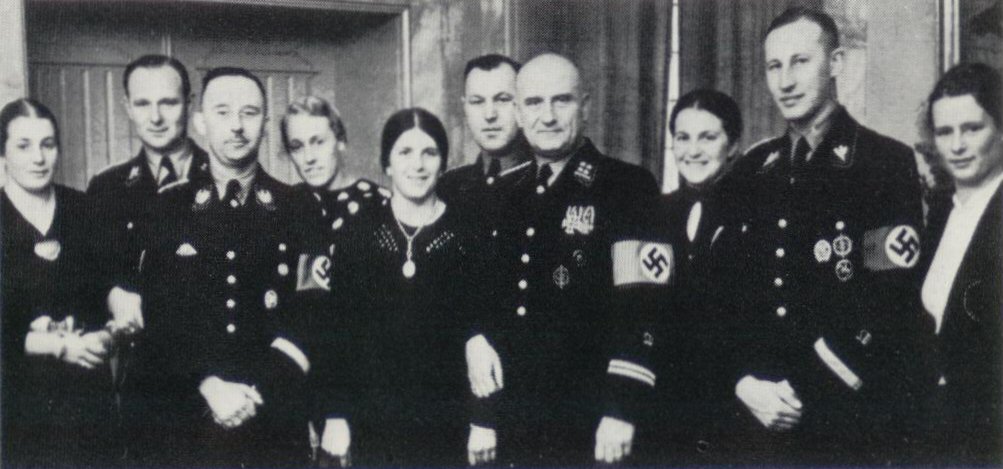|
Concentration Camps Inspectorate
The Concentration Camps Inspectorate (CCI) or in German, IKL (''Inspektion der Konzentrationslager''; ) was the central SS administrative and managerial authority for the concentration camps of the Third Reich. Created by Theodor Eicke, it was originally known as the "General Inspection of the Enhanced '' SS-Totenkopfstandarten''", after Eicke's position in the SS. It was later integrated into the SS Main Economic and Administrative Office as "Amt D". Inspector of all concentration camps SS-''Oberführer'' Theodor Eicke, became commandant of Dachau concentration camp on 26 June 1933. His form of organization at Dachau stood as the model for all later concentration camps. Eicke claimed the title of "Concentration Camps Inspector" for himself by May 1934. As part of the disempowerment of the SA through murder during the "Night of the Long Knives" he had personally shot Ernst Röhm on 1 July 1934. Shortly after the Röhm affair on 4 July 1934, ''Reichsführer-SS'' Heinrich Himml ... [...More Info...] [...Related Items...] OR: [Wikipedia] [Google] [Baidu] |
Bundesarchiv Bild 183-R97512, Berlin, Geheimes Staatspolizeihauptamt
The German Federal Archives or Bundesarchiv (BArch) (, lit. "Federal Archive") are the national archives of Germany. They were established at the current location in Koblenz in 1952. They are subordinated to the Federal Commissioner for Culture and the Media (Claudia Roth since 2021) under the German Chancellery, and before 1998, to the Federal Ministry of the Interior (Germany), Federal Ministry of the Interior. On 6 December 2008, the Archives donated 100,000 photos to the public, by making them accessible via Wikimedia Commons. History The federal archive for institutions and authorities in Germany, the first precursor to the present-day Federal Archives, was established in Potsdam, Brandenburg in 1919, a later date than in other European countries. This national archive documented German government dating from the founding of the North German Confederation in 1867. It also included material from the older German Confederation and the Imperial Chamber Court. The oldest docum ... [...More Info...] [...Related Items...] OR: [Wikipedia] [Google] [Baidu] |
Heinrich Himmler
Heinrich Luitpold Himmler (; 7 October 1900 – 23 May 1945) was a German Nazism, Nazi politician and military leader who was the 4th of the (Protection Squadron; SS), a leading member of the Nazi Party, and one of the most powerful people in Nazi Germany. He is primarily known for being one of the main architects of the Holocaust. After serving in a reserve battalion during World War I without seeing combat, Himmler went on to join the Nazi Party in 1923. In 1925, he joined the SS, a small paramilitary arm of the Nazi Party that served as a bodyguard unit for Adolf Hitler. Subsequently, Himmler rose steadily through the SS's ranks to become by 1929. Under Himmler's leadership, the SS grew from a 290-man battalion into one of the most powerful institutions within Nazi Germany. Over the course of his career, Himmler acquired a reputation for good organisational skills as well as for selecting highly competent subordinates, such as Reinhard Heydrich. From 1943 onwards, ... [...More Info...] [...Related Items...] OR: [Wikipedia] [Google] [Baidu] |
Oranienburg
Oranienburg () is a town in Brandenburg, Germany. It is the capital of the district of Oberhavel. Geography Oranienburg is on the banks of the River Havel, 35 km north of the centre of Berlin. Division of the town Oranienburg consists of nine districts: * Friedrichsthal * Germendorf * Lehnitz * Malz * Oranienburg * Sachsenhausen * Schmachtenhagen * Wensickendorf * Zehlendorf History Originally named Bötzow, the town of Oranienburg dates from the 12th century and was first mentioned in 1216. Margrave Albert the Bear (ruled 1157–1170) allegedly ordered the construction of a castle on the banks of the Havel. Around the castle stood a settlement of traders and craftsmen. In 1646, Friedrich Wilhelm I of Brandenburg married Louise Henriette of Orange-Nassau (German: ''Oranien-Nassau''). She was so attracted by the town of Bötzow that her husband presented the entire region to her. The princess ordered the construction of a new castle in the Dutch style and called it ... [...More Info...] [...Related Items...] OR: [Wikipedia] [Google] [Baidu] |
Staff (military)
A military staff or general staff (also referred to as army staff, navy staff, or air staff within the individual services) is a group of officers, enlisted, and civilian staff who serve the commander of a division or other large military unit in their command and control role through planning, analysis, and information gathering, as well as by relaying, coordinating, and supervising the execution of their plans and orders, especially in case of multiple simultaneous and rapidly changing complex operations. They are organised into functional groups such as administration, logistics, operations, intelligence, training, etc. They provide multi-directional flow of information between a commanding officer, subordinate military units and other stakeholders.PK Mallick, 2011Staff System in the Indian Army: Time for Change Centre for Land Warfare Studies, New Delhi, vol 31. A centralised general staff results in tighter top-down control but requires larger staff at hea ... [...More Info...] [...Related Items...] OR: [Wikipedia] [Google] [Baidu] |
Richard Glücks
Richard Glücks (; 22 April 1889 – 10 May 1945) was a high-ranking German SS functionary during the Nazi era. From November 1939 until the end of World War II, he commanded the Concentration Camps Inspectorate, later integrated into the SS Main Economic and Administrative Office as "Amt D". Reporting first to Theodor Eicke, then to SS chief Heinrich Himmler and finally to Oswald Pohl, he became Inspector of Concentration Camps. He retained this position despite Himmler, in whose presence Glücks would panic, having little confidence in him. Glücks was responsible for the forced labour of camp inmates and was the supervisor for the medical practices in the camps, ranging from Nazi human experimentation to the implementation of the "Final Solution", in particular the mass murder of inmates with Zyklon B gas. After Germany capitulated, Glücks committed suicide by swallowing a potassium cyanide capsule. Early life Glücks was born 1889, in Odenkirchen in the Rhineland. H ... [...More Info...] [...Related Items...] OR: [Wikipedia] [Google] [Baidu] |
SS-Amt
The SS Main Office (; SS-HA) was the central command office of the ''Schutzstaffel'' (SS) in Nazi Germany until 1940. Formation The office traces its origins to 1931 when the SS created the SS-Amt to serve as an SS Headquarters staff overseeing the various units of the ''Allgemeine-SS'' (General SS). In 1933, after the Nazi Party came to power, the SS-Amt was renamed the ''SS-Oberführerbereichen'' and placed in command of all SS units within Nazi Germany. Its leaders were Ernst Bach (December 1932 to June 1933), Siegfried Seidel-Dittmarsch (June 1933 to February 1934) and Curt Wittje (from February 1934). This agency then became the SS-HA on January 30, 1935. The organization oversaw the ''Allgemeine-SS'', concentration camps, the ''SS-Verfügungstruppe'' (Special-purpose troops), and the ''Grenzschutz'' (Border Control regiments). During the late 1930s, the power of the SS-HA continued to grow becoming the largest and most powerful office of the SS, managing nearly all aspect ... [...More Info...] [...Related Items...] OR: [Wikipedia] [Google] [Baidu] |
Sicherheitsdienst
' (, "Security Service"), full title ' ("Security Service of the ''Reichsführer-SS''"), or SD, was the intelligence agency of the Schutzstaffel, SS and the Nazi Party in Nazi Germany. Established in 1931, the SD was the first Nazi intelligence organization and the Gestapo (formed in 1933) was considered its sister organization through the integration of SS members and operational procedures. The SD was administered as an independent SS office between 1933 and 1939. That year, the SD was transferred over to the Reich Security Main Office (''Reichssicherheitshauptamt''; RSHA), as one of its seven departments. Its first director, Reinhard Heydrich, intended for the SD to bring every single individual within the Third Reich's reach under "continuous supervision". Following Germany's defeat in World War II, the tribunal at the Nuremberg trials officially declared that the SD was a criminal organisation, along with the rest of Heydrich's RSHA (including the Gestapo) both individually ... [...More Info...] [...Related Items...] OR: [Wikipedia] [Google] [Baidu] |
Reinhard Heydrich
Reinhard Tristan Eugen Heydrich ( , ; 7 March 1904 – 4 June 1942) was a German high-ranking SS and police official during the Nazi era and a principal architect of the Holocaust. He held the rank of SS-. Many historians regard Heydrich as one of the darkest figures within the Nazi regime. Adolf Hitler described him as "the man with the iron heart." Heydrich was chief of the Reich Security Main Office (including the Gestapo, Kriminalpolizei (Nazi Germany), Kripo, and Sicherheitsdienst, SD). He was also (Deputy/Acting Reich-Protector) of Protectorate of Bohemia and Moravia, Bohemia and Moravia. He served as president of the International Criminal Police Commission (ICPC, now known as Interpol) and chaired the January 1942 Wannsee Conference which formalised plans for the "Final Solution to the Jewish question"—the deportation and genocide of all Jews in German-occupied Europe. He was the founding head of the (Security Service, SD), an intelligence organisation charg ... [...More Info...] [...Related Items...] OR: [Wikipedia] [Google] [Baidu] |
Holocaust
The Holocaust (), known in Hebrew language, Hebrew as the (), was the genocide of History of the Jews in Europe, European Jews during World War II. From 1941 to 1945, Nazi Germany and Collaboration with Nazi Germany and Fascist Italy, its collaborators systematically murdered some six million Jews across German-occupied Europe, around two-thirds of Europe's Jewish population. The murders were carried out primarily through mass shootings and poison gas in extermination camps, chiefly Auschwitz concentration camp#Auschwitz II-Birkenau, Auschwitz-Birkenau, Treblinka extermination camp, Treblinka, Belzec extermination camp, Belzec, Sobibor extermination camp, Sobibor, and Chełmno extermination camp, Chełmno in Occupation of Poland (1939–1945), occupied Poland. Separate Nazi persecutions killed a similar or larger number of non-Jewish civilians and prisoners of war (POWs); the term ''Holocaust'' is sometimes used to include the murder and persecution of Victims of Nazi ... [...More Info...] [...Related Items...] OR: [Wikipedia] [Google] [Baidu] |
Topography Of Terror
The Topography of Terror () is an outdoor and indoor history museum in Berlin, Germany. It is located on Niederkirchnerstrasse, formerly Prinz-Albrecht-Strasse, on the site of buildings, which during the Nazi Germany, Nazi regime from 1933 to 1945 was the Schutzstaffel, SS Reich Security Main Office, the headquarters of the Sicherheitspolizei, Sicherheitsdienst, SD, Einsatzgruppen and Gestapo. The buildings that housed the Gestapo and SS headquarters were largely destroyed by Allied bombing during early 1945 and the ruins demolished after the war. The boundary between the American and Soviet zones of occupation in Berlin ran along the Prinz-Albrecht-Strasse, so the street soon became a fortified boundary, and the Berlin Wall ran along the south side of the street, renamed Niederkirchnerstrasse, from 1961 to 1989. The wall here was never demolished. The section adjacent to the Topography of Terror site is the longest extant segment of the outer wall, as the longer East Side Gall ... [...More Info...] [...Related Items...] OR: [Wikipedia] [Google] [Baidu] |
Berlin
Berlin ( ; ) is the Capital of Germany, capital and largest city of Germany, by both area and List of cities in Germany by population, population. With 3.7 million inhabitants, it has the List of cities in the European Union by population within city limits, highest population within its city limits of any city in the European Union. The city is also one of the states of Germany, being the List of German states by area, third smallest state in the country by area. Berlin is surrounded by the state of Brandenburg, and Brandenburg's capital Potsdam is nearby. The urban area of Berlin has a population of over 4.6 million and is therefore the most populous urban area in Germany. The Berlin/Brandenburg Metropolitan Region, Berlin-Brandenburg capital region has around 6.2 million inhabitants and is Germany's second-largest metropolitan region after the Rhine-Ruhr region, as well as the List of EU metropolitan areas by GDP, fifth-biggest metropolitan region by GDP in the European Union. ... [...More Info...] [...Related Items...] OR: [Wikipedia] [Google] [Baidu] |







